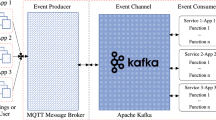Abstract
One class of applications envisaged for the IEEE 802.15.4 LR-WPAN (low data rate—wireless personal area network) standard is wireless sensor networks for monitoring and control applications. In this paper we provide an analytical performance model for a network in which the sensors are at the tips of a star topology, and the sensors need to transmit their measurements to the hub node so that certain objectives for packet delay and packet discard are met. We first carry out a saturation throughput analysis of the system; i.e., it is assumed that each sensor has an infinite backlog of packets and the throughput of the system is sought. After a careful analysis of the CSMA/CA MAC that is employed in the standard, and after making a certain decoupling approximation, we identify an embedded Markov renewal process, whose analysis yields a fixed point equation, from whose solution the saturation throughput can be calculated. We validate our model against ns2 simulations (using an IEEE 802.15.4 module developed by Zheng [14]). We find that with the default back-off parameters the saturation throughput decreases sharply with increasing number of nodes. We use our analytical model to study the problem and we propose alternative back-off parameters that prevent the drop in throughput. We then show how the saturation analysis can be used to obtain an analytical model for the finite arrival rate case. This finite load model captures very well the qualitative behavior of the system, and also provides a good approximation to the packet discard probability, and the throughput. For the default parameters, the finite load throughput is found to first increase and then decrease with increasing load. We find that for typical performance objectives (mean delay and packet discard) the packet discard probability would constrain the system capacity. Finally, we show how to derive a node lifetime analysis using various rates and probabilities obtained from our performance analysis model.
Similar content being viewed by others
References
IEEE std. 802.15.4, Part 15.4:Wireless MAC and PHY specifications for Low-Rate Wireless Personal Are Networks, (2003).
Alliance, Z. B. (2003). Draft standard: 02130r4ZB-NWK-Network layer specification, March
Ameer, P. M. (2006). Analysis fo Zigbee Network Architectures for Industrial Sensor Networks, Master of Engineering Thesis, ECE Department, Indian Institute of Science, Bangalore, June 2006
Bianchi, G. (2000). Performance analysis of the IEEE 802.11 Distributed Coordination Function. IEEE JSAC, 18(3), 535–547.
Callaway, Ed, Gorday, P., Hester, L., Gutierrez, J. A., Neave, M., Heile, B., & Bahl, V. (2002) Home Networking with 802.15.4: A developing standard for low-rate wireless personal area networks. IEEE Communication Magazine, 40(8), 70–77.
Chipcon Data Sheet for CC2420 2.4 GHz IEEE 802.15.4/ZigBee RF Transceiver, 2004., http://www.chipcon.com/files/CC2420 Data Sheet 1 3.pdf
Golmie, N., Cypher, D., & Rebala, O. (2005). Performance analysis of low rate wireless technologies for medical applications. Elsevier Comp. and Commun. 28(10), 1266–1275.
Goyal, M. (2003). Stochastic Control of Wireless Transmissions over Multiaccess Fading Channels. Phd Thesis, IISc, December 2003.
Kinney, P. (2003). ZigBee technology: Wireless control that simply works. Communication Design Conference, October 2003.
Kumar, A., Altman, E., Miorandi, D., & Goyal M. (2007). New Insights from a Fixed Point Analysis of Single Cell IEEE 802.11 WLANs. IEEE INFOCOM, 3, 1550–1561, March 2005. Also to appear in IEEE Transactions on Networking
Zheng, J., & Lee, M. J. (2004). Will IEEE 802.15.4 Make Ubiquitous networking a reality?– A discussion on a potential low power, low bit rate standard. IEEE Communications Magazine, 42(6), 140–146.
Lu, G., Krishnamachari, B., & Raghavendra, C. S. (2004). Performance Evaluation of the IEEE 802.15.4 MAC for Low-Rate Low-Power Wireless Networks. IEEE IPCCC, 701–706.
Timmons, N. F., & Scanlon, W. G. (2004). Analysis of the performance of IEEE 802.15.4 for medical sensor body area networking. IEEE SECON, 04, 16–24.
Zheng, J. ns. 802.15.4 source code, http://ees2cy.engr.ccny.cuny.edu/zheng/pub/index.html
Zheng, J., & Lee, M. J. (2006). A comprehensive performance study of IEEE 802.15.4. Sensor network operations (Chapter 4, pp. 218–237). IEEE Press, Wiley Interscience.
Kohvakka, M., Kuorilehto, M., Hannikainen, M., & Hamalainen, T. D. (2006). Performance analysis of IEEE 802.15.4 and ZigBee for large-scale wireless sensor network applications. ACM PE-WASUN, 48–57.
Misic, J., Shafi, S., & Misic, V. B. (2006). Performance of a beacon enabled IEEE 802.15.4 cluster with downlink and uplink traffic. IEEE Transactions on Parallel and Distributed Systems, 17(4), 361–376.
Pollin, S., Ergen, M., Ergen, S. C., Bougard, B., Van der Perre, L., Catthoor, F., Moerman, I., Bahai, A., & Varaiya, P. (2006). Performance analysis of slotted carrier sense IEEE 802.15.4 medium access layer. IEEE GLOBECOM, 1–6
Park, T. R., Kim, T. H., Choi, J. Y., Choi, S., & Kwon, W. H. (2005). Throughput and energy consumption analysis of IEEE 802.15.4 slotted CSMA/CA. Electronic Letters, 41(18), 1017–1019.
Leibnitz, K., Wakamiya, N., & Murata, M. (2005). Modeling of IEEE 802.15.4 in a cluster of synchronized sensor nodes. ITC, 19, 1345–1354.
Tao, Z., Panwar, S., Gu, D., & Zhang, J. (2006). Performance analysis and a proposed improvement for the IEEE 802.15.4 contention access period. IEEE WCNC, 4, 1811–1818.
Ramachandran, I., Das, A. K., & Roy, S. (2007). Analysis of the Contention Access Period of IEEE 802.15.4 MAC. ACM TOSN, 3(1), article 4.
Ramachandran, I., Changes made to the IEEE 802.15.4 NS-2 Implementation, http://www.ee.washington.edu/research/funlab/802154/ns2 changes.pdf
Koubaa, A., Alves, M., & Tovar, E. (2006). i-GAME: AN implicit GTS allocation mechanism in IEEE 802.15.4 for time-sensitive wireless sensor networks. IEEE ECRTS, 10–19.
Koubaa, A., Alves, M., & Tovar, E. (2006). A comprehensive simulation study of slotted CSMA/CA for IEEE 802.15.4 wireless sensor networks. IEEE WFCS, 183–192.
Acknowledgements
The work was sponsored by the Honeywell Technology Solutions Lab., Bangalore, India.
Author information
Authors and Affiliations
Corresponding author
Rights and permissions
About this article
Cite this article
Singh, C.K., Kumar, A. & Ameer, P.M. Performance evaluation of an IEEE 802.15.4 sensor network with a star topology. Wireless Netw 14, 543–568 (2008). https://doi.org/10.1007/s11276-007-0043-8
Published:
Issue Date:
DOI: https://doi.org/10.1007/s11276-007-0043-8




